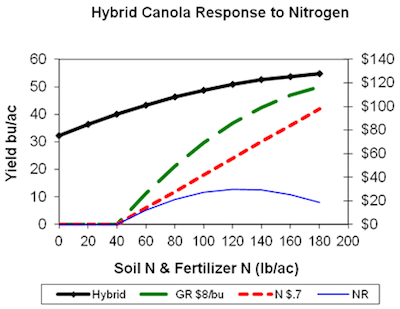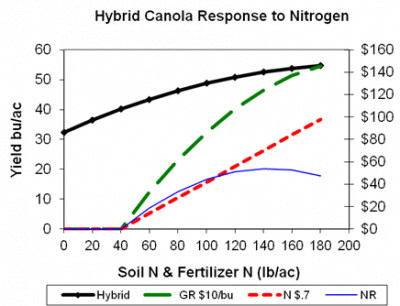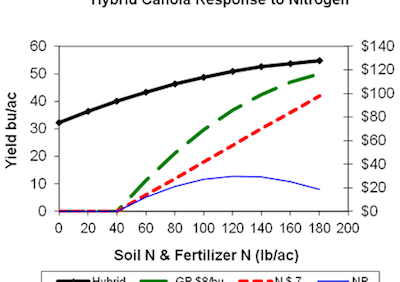

These two figures show the yield response of hybrid canola to total nitrogen (applied plus soil reserve). The figures are for $8/bu canola and $10/bu canola. The cost of nitrogen is 70 cents per pound of N. The blue line is what matters when assessing the return on investment and your risk assessment with regard to nitrogen. Here’s how to read the figure:
The black line represents the rise in canola yield as nitrogen rate increases.
The red line shows the cost of applied nitrogen. Note the red line does not start rising until 40 lb./ac., which is the assumed residual N in the soil.
The green line shows the gross return to applying N fertilizer, based on the given canola price and the yield curve.
The blue line is the important line. It shows the net return on nitrogen — which is the relationship between the cost of nitrogen and the gross revenue generated as a result of that nitrogen investment. When the blue line goes flat, that means the cost of nitrogen and the gross revenue are equal — $1 invested in N will return $1 in revenue. The point at which the net return line is greatest (goes flat) represents the maximum economical rate of N (MERN), but whether a grower wants to apply this rate will depend on risk factors. For example:
—Moisture conditions during the growing season greatly affect the response to fertilizer N, but growing season weather isn’t predictable. Dry conditions may reduce yield potential, which will drop the green line and shift the blue line to the left. The most economic nitrogen rate may be lower in that case.
—Ideal moisture conditions and better price prospects may increase the green line’s potential, shifting the blue line to the right and improving the return on investment for extra nitrogen. Growers with a higher appetite for risk may apply nitrogen rates at or above the current MERN (the last 10 lb./ac. of N provides a 1:1 return on investment according to the model) expecting the model conditions to improve and the MERN to increase.
—Growers with a lower appetite for risk will notice that the blue line is fairly flat over a wide range of nitrogen rates. They should opt for a rate lower than the MERN. They may prefer a rate where the last 10 lb./ac. of nitrogen applied will provide a $1.25 or $1.50 return on each $1 invested instead of a 1:1 return.
Enter your own parameters
Here are two online calculators where you can enter your own canola price and nitrogen price to come up with results specific to your 2014 situation and outlook.
MAFRD calculator: nitrogencalculatorver1.0 If this file does not open properly, click here and scroll down to the Nitrogen Calculator under the “Crops” heading. With the calculator, enter your own figures in any of the yellow boxes — urea price and soil reserve nitrogen, for examples. Then scroll down to see tables for each crop. Adjusting the yellow box entries will automatically adjust the tables.
Alberta Farm Fertilizer Information and Recommendation Manager (AFFIRM)
Click here for more on this topic, including wheat and barley data.

